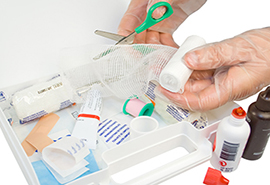
First Aid Kits Contents
A well-stocked first-aid kit, kept within easy reach, is a necessity in every home. Having supplies gathered ahead of time will help you respond effectively to injuries and emergencies at a moment's notice. You should keep at least one first-aid kit in your home, in your car and at work in easy-to-retrieve locations that are out of the reach of young children.
What should be in a first-aid kit?
- First-aid manual
- Adhesive tape, adhesive bandages in assorted sizes, elastic bandage and bandage strips (Band-Aid)
- Antibiotic cream, solution, towelettes or wipes
- Thermometer
- Cotton balls and cotton-tipped swabs
- Sterile gauze, gauze pads and roller gauze in assorted sizes
- Soap or instant hand sanitizer
- Eye goggles
- Disposable instant cold packs
- Lubricants such as petroleum jelly
- Plastic bags for the disposal of contaminated materials
- Safety pins in assorted sizes
- Sharp scissors, tweezers and a needle
- Sterile eyewash, such as a saline solution
- Aluminum finger splints
- A bulb suction device for flushing out wounds
- Hydrocortisone cream (1%)
- Calamine lotion
- Alcohol wipes or ethyl alcohol
- Small, waterproof flashlight and extra batteries
- Mouthpiece for administering CPR (can be obtained from your local Red Crescent)
- Disposable latex or plastic gloves
- Activated charcoal (use only if instructed by your poison control center)
- Anti-diarrhea medication
- Over-the-counter oral antihistamine (Benadryl)
- Aspirin and nonaspirin pain relievers (never give aspirin to children)
- Over-the-counter hydrocortisone cream
- Personal medications
- If prescribed by your doctor, drugs to treat an allergic attack, such as an auto-injector of epinephrine (EpiPen)
- Syringe, medicine cup or spoon
- Cell phone and re-charger that utilizes the accessory plug in your car dash
- Emergency phone numbers
- Candles and matches for cold climates
- Emergency blanket
- Sunscreen
After stocking the first-aid kits:
- Read the first-aid manual to understand how to use the kits and review the manuals with your kids.
- Store first-aid kits in places that are out of children's reach but easily accessible for adults.
- Check the kits regularly every three months. Replace missing items or medicines that may have expired and make sure the flashlight batteries work.


